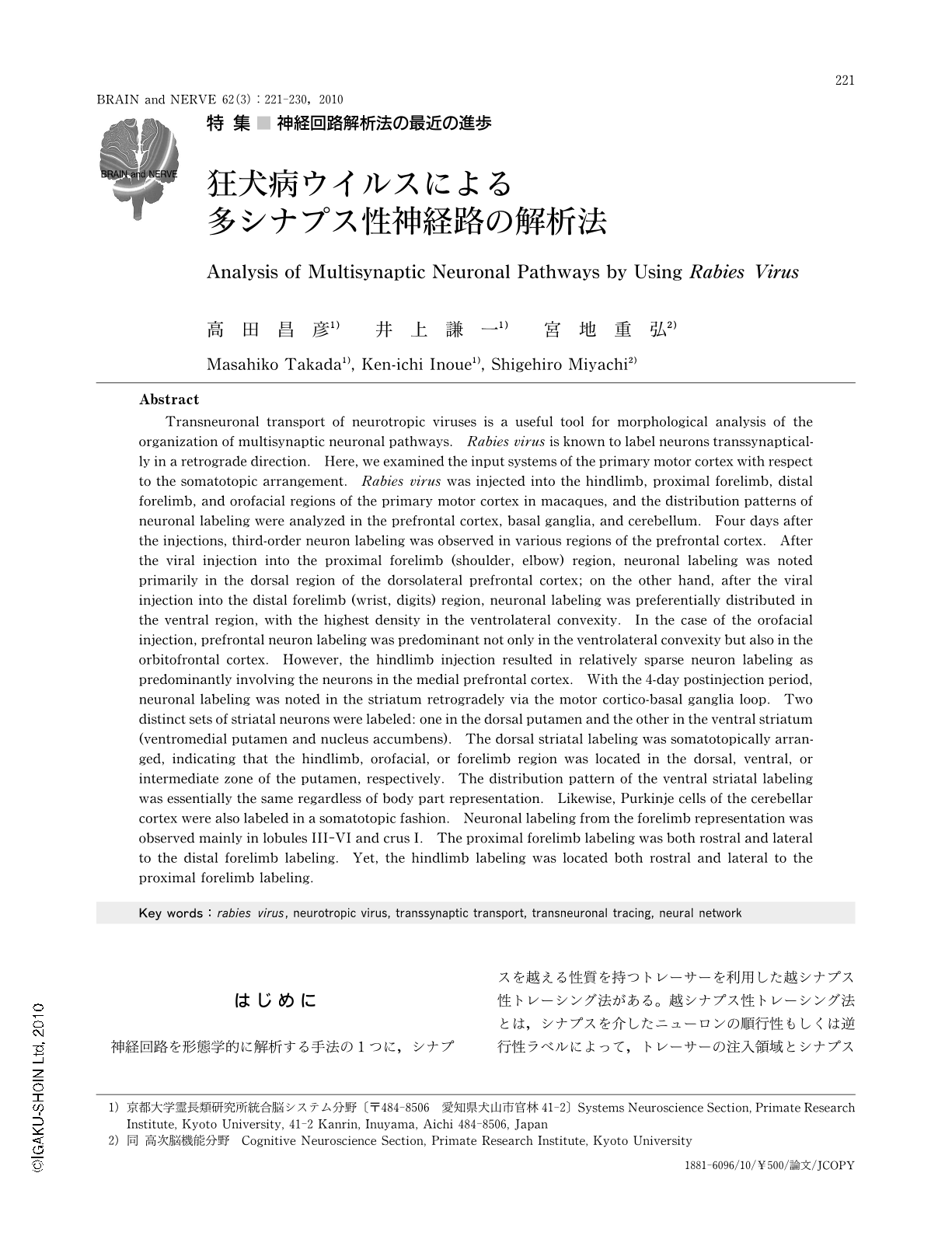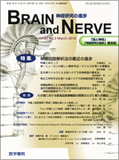Japanese
English
- 有料閲覧
- Abstract 文献概要
- 1ページ目 Look Inside
- 参考文献 Reference
はじめに
神経回路を形態学的に解析する手法の1つに,シナプスを越える性質を持つトレーサーを利用した越シナプス性トレーシング法がある。越シナプス性トレーシング法とは,シナプスを介したニューロンの順行性もしくは逆行性ラベルによって,トレーサーの注入領域とシナプスを経由して連絡するニューロングループを直接検出できる手法である。この手法は,従来の単シナプス性トレーサーを用いた解析法では困難であった,特定の多シナプス性神経路を容易に同定できるという点で,神経回路の系統的解析には極めて有効である(Fig.1)。越シナプス性トレーサーとして,wheat germ agglutinin(WGA)やcholera toxin subunit B(CTB)など,通常単シナプス性トレーサーとして使用している化学物質が応用できるという報告もあるが,神経向性ウイルスを利用することが最も有効であることはよく知られている1-3)。一部の神経向性ウイルスでは,ウイルス粒子が軸索末端からニューロンに取り込まれて,逆行性輸送により細胞体まで運ばれ,自身を複製して増殖した後,感染したニューロンとシナプス結合を有するニューロンにシナプスを介して伝播する。このような神経向性ウイルスを用いた越シナプス性トレーシング法の最大の特徴は,シナプスを越えて伝播したウイルスが感染ニューロンにおいて転写・複製反応を行うため,ニューロンラベルを形態学的に検出する際のシグナルが増幅されることである。したがって,このシグナル増幅により,シナプスを介して2次的,3次的に結合するニューロン(2次ニューロン,3次ニューロン)においても強いラベルを実現することが可能になる。すなわち,神経向性ウイルストレーサーには,シナプスを越えるたびにシグナルが減衰するため検出が困難になるという,WGAやCTBなどの化学物質が持つ問題を克服できる利点がある(Fig.2)。越シナプス性トレーシング法に用いられる神経向性ウイルスとして,古くは単純ヘルペスウイルスⅠ型(herpes simplex virus type I)やブタヘルペスウイルス(pseudorabies virus)など,ヘルペスウイルス科のウイルスが挙げられるが4-6),狂犬病ウイルス(rabies virus)が近年注目を集めている。本稿では,狂犬病ウイルスによる越シナプス性トレーシング法と運動系神経回路を例にした多シナプス性神経路の解析について概説するとともに,遺伝子改変を加えた狂犬病ウイルスベクター利用した神経回路解析の可能性について言及する。
Abstract
Transneuronal transport of neurotropic viruses is a useful tool for morphological analysis of the organization of multisynaptic neuronal pathways. Rabies virus is known to label neurons transsynaptically in a retrograde direction. Here,we examined the input systems of the primary motor cortex with respect to the somatotopic arrangement. Rabies virus was injected into the hindlimb,proximal forelimb,distal forelimb,and orofacial regions of the primary motor cortex in macaques,and the distribution patterns of neuronal labeling were analyzed in the prefrontal cortex,basal ganglia,and cerebellum. Four days after the injections,third-order neuron labeling was observed in various regions of the prefrontal cortex. After the viral injection into the proximal forelimb (shoulder,elbow) region,neuronal labeling was noted primarily in the dorsal region of the dorsolateral prefrontal cortex; on the other hand,after the viral injection into the distal forelimb (wrist,digits) region,neuronal labeling was preferentially distributed in the ventral region,with the highest density in the ventrolateral convexity. In the case of the orofacial injection,prefrontal neuron labeling was predominant not only in the ventrolateral convexity but also in the orbitofrontal cortex. However,the hindlimb injection resulted in relatively sparse neuron labeling as predominantly involving the neurons in the medial prefrontal cortex. With the 4-day postinjection period,neuronal labeling was noted in the striatum retrogradely via the motor cortico-basal ganglia loop. Two distinct sets of striatal neurons were labeled: one in the dorsal putamen and the other in the ventral striatum (ventromedial putamen and nucleus accumbens). The dorsal striatal labeling was somatotopically arranged,indicating that the hindlimb,orofacial,or forelimb region was located in the dorsal,ventral,or intermediate zone of the putamen,respectively. The distribution pattern of the ventral striatal labeling was essentially the same regardless of body part representation. Likewise,Purkinje cells of the cerebellar cortex were also labeled in a somatotopic fashion. Neuronal labeling from the forelimb representation was observed mainly in lobules III-VI and crus I. The proximal forelimb labeling was both rostral and lateral to the distal forelimb labeling. Yet,the hindlimb labeling was located both rostral and lateral to the proximal forelimb labeling.

Copyright © 2010, Igaku-Shoin Ltd. All rights reserved.


